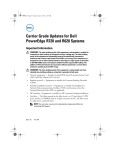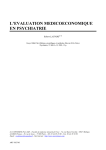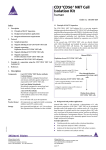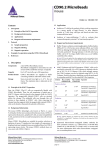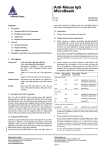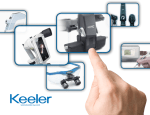Download Anti-Biotin MicroBeads
Transcript
Anti-Biotin MicroBeads Order no. 130-090-485 Contents 1.3 Applications 1. Description ● Positive selection or depletion, also of cells with low antigen expression. ● Some examples for the use of Anti-Biotin MicroBeads are the separation of murine α E–CD25+ and α E–CD25 – T cell subsets¹, isolation of CD45.2+ cells from the bone marrow of chimeric mice², or the enrichment of human CD94+ NK cells.³ 1.1 Principle of the MACS® Separation 1.2 Background information 1.3 Applications 1.4 Reagent and instrument requirements 2. Protocol 2.1 Sample preparation 2.2 Magnetic labeling 2.3 Magnetic separation 1.4 Reagent and instrument requirements ● Buffer: Prepare a solution containing phosphate-buffered saline (PBS), pH 7.2, 0.5% bovine serum albumin (BSA), and 2 mM EDTA by diluting MACS BSA Stock Solution (# 130091-376) 1:20 with autoMACS® Rinsing Solution (# 130-091222). Keep buffer cold (2−8 °C). Degas buffer before use, as air bubbles could block the column. ▲ Note: EDTA can be replaced by other supplements such as anticoagulant citrate dextrose formula-A (ACD-A) or citrate phosphate dextrose (CPD). BSA can be replaced by other proteins such as human serum albumin, human serum, or fetal bovine serum (FBS). Buffers or media containing Ca 2+ or Mg 2+ are not recommended for use. ● MACS Columns and MACS Separators: Labeled material can be enriched by using MS, LS, or XS Columns or depleted with the use of LD, CS, or D Columns. If labeling with biotinylated antibodies or molecules is sufficiently strong, magnetically labeled biological material can efficiently be depleted by using MS, LS, or XS Columns. Positive selection or depletion can also be performed by using the autoMACS Pro or the autoMACS Separator. 3. Example of a separation using the Anti-Biotin MicroBeads 4. References 1. Description Components 2 mL Anti-Biotin MicroBeads: MicroBeads conjugated to monoclonal mouse anti-biotin antibodies (isotype: mouse IgG1). Capacity For 10⁹ total cells, up to 100 separations. Product format Anti-Biotin MicroBeads are supplied in buffer containing stabilizer and 0.05% sodium azide. Storage Store protected from light at 2−8 °C. Do not freeze. The expiration date is indicated on the vial label. 1.1 Principle of the MACS® Separation Column First, the biological material of interest (e.g. cells, bacteria, or subcellular material) is labeled with biotinylated antibodies or ligands. Subsequently, the material is magnetically labeled with Anti-Biotin MicroBeads. Then, the cell suspension is loaded onto a MACS® Column, which is placed in the magnetic field of a MACS Separator. The magnetically labeled material is retained within the column. The unlabeled material runs through; this cell fraction is thus depleted of magnetically labeled material. After removing the column from the magnetic field, the magnetically retained material can be eluted as the positively selected cell fraction. To increase the purity, the positively selected cell fraction containing the magnetically labeled cells can be separated over a second column. Max. number of labeled cells Max. number Separator of total cells Positive selection MS 10⁷ 2 ×10⁸ MiniMACS, OctoMACS, VarioMACS, SuperMACS II LS 10⁸ 2 ×10⁹ MidiMACS, QuadroMACS, VarioMACS, SuperMACS II XS 10⁹ 2 ×10¹⁰ SuperMACS II 10⁸ 5 ×10⁸ MidiMACS, QuadroMACS, VarioMACS, SuperMACS II Depletion LD CS 2×10⁸ VarioMACS, SuperMACS II D 10⁹ SuperMACS II 140-000-542.09 1.2 Background information Positive selection or depletion Anti-Biotin MicroBeads have been developed for indirect magnetic labeling and separation of cells or other biological materials that are labeled with a biotinylated primary antibody or ligand, or with a cocktail of biotinylated antibodies. The biotinylated molecule is recognized by a monoclonal anti-biotin antibody coupled to MicroBeads. Anti-Biotin MicroBeads have the advantage of not binding to free biotin, which is often present in culture media. This feature provides the most sensitive labeling and separation of cells. autoMACS 2×10⁸ Miltenyi Biotec GmbH Friedrich-Ebert-Straße 68, 51429 Bergisch Gladbach, Germany Phone +49 2204 8306-0, Fax +49 2204 85197 [email protected] www.miltenyibiotec.com 4 ×10⁹ autoMACS Pro, autoMACS ▲ Note: Column adapters are required to insert certain columns into the VarioMACS™ or SuperMACS™ II Separators. For details refer to the respective MACS Separator data sheet. ● Biotin-conjugated antibody, peptide, or ligand. Miltenyi Biotec Inc. 2303 Lindbergh Street, Auburn, CA 95602, USA Phone 800 FOR MACS, +1 530 888 8871, Fax +1 530 888 8925 [email protected] page 1/4 Order no. 130-090-485 ● ● ● (Optional) FcR Blocking Reagent, human (# 130-059-901)/ mouse (# 130-092-575) to avoid Fc receptor–mediated antibody labeling when using human or mouse samples. (Optional) Fluorochrome-conjugated anti-biotin antibody for flow cytometric analysis, e.g., Anti-Biotin-FITC (# 130‑090‑857), Anti-Biotin-PE (# 130-090-756), or Anti‑Biotin-APC (# 130-090-856). For more information about fluorochrome conjugates refer to www.miltenyibiotec.com. (Optional) Propidium Iodide Solution (# 130-093-233) or 7-AAD for flow cytometric exclusion of dead cells. ● (Optional) Dead Cell Removal Kit (# 130-090-101) for the depletion of dead cells. ● (Optional) Pre-Separation Filters (# 130-041-407) to remove cell clumps. 1. Determine cell number. 2. (Optional) Add FcR Blocking Reagent, human or mouse in appropriate ratio. For details refer to the respective FcR Blocking Reagent data sheet. 3. Label cells with the biotinylated antibody using time and titer according to manufacturer´s instructions. Typically, staining for 5 minutes is sufficient. ▲ Note: The biotinylated antibody should be used at its optimal titer, i.e. with optimal staining intensity and no background staining. 4. Wash cells by adding 1−2 mL of buffer per 10⁷ cells and centrifuge at 300×g for 10 minutes. Aspirate supernatant completely. 5. Repeat step 4. 6. Resuspend cell pellet in appropriate amount of buffer per 10⁷ total cells. 2. Protocol 2.1 Sample preparation When labeling without using FcR Blocking Reagent, resuspend in 80 µL of buffer. When working with anticoagulated peripheral blood or buffy coat, peripheral blood mononuclear cells (PBMCs) should be isolated by density gradient centrifugation, for example, using Ficoll-Paque™. When MACS FcR Blocking Reagent, human has been used resuspend in 60 µL of buffer. When MACS FcR Blocking Reagent, mouse has been used resuspend in 70 µL of buffer. 7. Add 20 µL of Anti-Biotin MicroBeads per 10⁷ total cells. ▲ Note: To remove platelets after density gradient separation, resuspend cell pellet in buffer and centrifuge at 200×g for 10−15 minutes at 20 °C. Carefully aspirate supernatant. Repeat washing step. When working with tissues or lysed blood, prepare a single-cell suspension using standard methods. When working with mouse lymphoid organs, mouse non‑lymphoid tissues, or mouse peripheral blood, prepare a single-cell suspension using manual methods or the gentleMACS™ Dissociator. For details refer to the protocols section at www.miltenyibiotec.com/ protocols. ▲ Dead cells may bind non-specifically to MACS MicroBeads. To remove dead cells, we recommend using density gradient centrifugation or the Dead Cell Removal Kit (# 130-090-101). 2.2 Magnetic labeling 8. Mix well and incubate for 15 minutes in the refrigerator (2−8 °C). 9. (Optional) Add staining antibodies, e.g., 10 µL ofAnti-BiotinFITC (# 130-090-857), and incubate for 5 minutes in the dark in the refrigerator (2−8 °C). 10. Wash cells by adding 1−2 mL of buffer per 10⁷ cells and centrifuge at 300×g for 10 minutes. Aspirate supernatant completely. 11. Resuspend up to 10⁸ cells in 500 µL of buffer. ▲ Note: For higher cell numbers, scale up buffer volume accordingly. ▲ Note: For depletion with LD Columns, resuspend up to 1.25×10⁸ cells in 500 µL of buffer. 12. Proceed to magnetic separation (2.3). ▲ Work fast, keep cells cold, and use pre-cooled solutions. This will prevent capping of antibodies on the cell surface and non-specific cell labeling. ▲ Volumes for magnetic labeling given below are for up to 10⁷ total cells. When working with fewer than 10⁷ cells, use the same volumes as indicated. When working with higher cell numbers, scale up all reagent volumes and total volumes accordingly (e.g. for 2×10⁷ total cells, use twice the volume of all indicated reagent volumes and total volumes). ▲ For optimal performance it is important to obtain a single‑cell suspension before magnetic labeling. Pass cells through 30 µm nylon mesh (Pre-Separation Filters, # 130-041-407) to remove cell clumps which may clog the column. Moisten filter with buffer before use. ▲ The recommended incubation temperature is 2–8 °C. Higher temperatures and/or longer incubation times may lead to non‑specific cell labeling. Working on ice may require increased incubation times. 140-000-542.09 Unless otherwise specifically indicated, Miltenyi Biotec products and services are for research use only and not for diagnostic or therapeutic use. page 2/4 Order no. 130-090-485 Depletion with CS Columns 2.3 Magnetic separation ▲ Choose an appropriate MACS Column and MACS Separator according to the number of total cells and the number of magnetically labeled cells. For details refer to the table in section 1.4. 1. Assemble CS Column and place it in the magnetic field of a suitable MACS Separator. For details refer to the CS Column data sheet. ▲ Always wait until the column reservoir is empty before proceeding to the next step. 2. Prepare column by filling and rinsing with 60 mL of buffer. Attach a 22G flow resistor to the 3-way stopcock of the assembled column. For details refer to the CS Column data sheet. Magnetic separation with MS or LS Columns 3. Apply cell suspension onto the column. 1. 4. Collect unlabeled cells that pass through and wash column with 30 mL buffer from the top. Collect total effluent; this is the unlabeled cell fraction. Place column in the magnetic field of a suitable MACS Separator. For details refer to the respective MACS Column data sheet. 2. Prepare column by rinsing with the appropriate amount of buffer: MS: 500 µL LS: 3 mL 3. Apply cell suspension onto the column. Collect flow-through containing unlabeled cells. 4. Wash column with the appropriate amount of buffer. Collect unlabeled cells that pass through and combine with the effluent from step 3. MS: 3×500 µL LS: 3×3 mL ▲ Note: Perform washing steps by adding buffer aliquots only when the column reservoir is empty. 5. Remove column from the separator and place it on a suitable collection tube. 6. Pipette the appropriate amount of buffer onto the column. Immediately flush out the magnetically labeled cells by firmly pushing the plunger into the column. 7. MS: 1 mL LS: 5 mL (Optional) To increase the purity of magnetically labeled cells, the eluted fraction can be enriched over a second MS or LS Column. Repeat the magnetic separation procedure as described in steps 1 to 6 by using a new column. Magnetic separation with XS Columns For instructions on the column assembly and the separation refer to the XS Column data sheet. Depletion with D Columns For instructions on column assembly and separation refer to the D Column data sheet. Magnetic separation with the autoMACS® Pro Separator or the autoMACS® Separator ▲ Refer to the respective user manual for instructions on how to use the autoMACS® Pro Separator or the autoMACS Separator. ▲ Buffers used for operating the autoMACS Pro Separator or the autoMACS Separator should have a temperature of ≥10 °C. ▲ Program choice depends on the isolation strategy, the strength of magnetic labeling, and the frequency of magnetically labeled cells. For details refer to the section describing the cell separation programs in the respective user manual. Magnetic separation with the autoMACS® Pro Separator 1. Prepare and prime the instrument. 2. Apply tube containing the sample and provide tubes for collecting the labeled and unlabeled cell fractions. Place sample tube in row A of the tube rack and the fraction collection tubes in rows B and C. 3. Choose an appropriate program according to the recommendations in the autoMACS Pro Separator user manual. Magnetic separation with the autoMACS® Separator Depletion with LD Columns 1. Prepare and prime the instrument. 1. 2. Apply tube containing the sample and provide tubes for collecting the labeled and unlabeled cell fractions. Place sample tube at the uptake port and the fraction collection tubes at port neg1 and the appropriate port for the positive fraction. 3. Choose an appropriate program according to the recommendations in the autoMACS Separator user manual. Place LD Column in the magnetic field of a suitable MACS Separator. For details refer to the LD Column data sheet. 2. Prepare column by rinsing with 2 mL of buffer. 3. Apply cell suspension onto the column. 4. Collect unlabeled cells that pass through and wash column with 2×1 mL of buffer. Collect total effluent; this is the unlabeled cell fraction. Perform washing steps by adding buffer two times. Only add new buffer when the column reservoir is empty. 140-000-542.09 Unless otherwise specifically indicated, Miltenyi Biotec products and services are for research use only and not for diagnostic or therapeutic use. page 3/4 Order no. 130-090-485 3. Example of a separation using the Anti-Biotin MicroBeads Separation of human PBMCs using biotinylated mouse anti-human CD3 antibody, the Anti-Biotin MicroBeads, an MS Column, and a MiniMACS™ Separator. Cells are fluorescently stained with Anti‑Biotin-PE (# 130-090-756). Cell debris and dead cells are excluded from the analysis based on scatter signals and propidium iodide fluorescence. PBMCs before separation 4. References 1. Lehmann, J. et al. (2002) Expression of the integrin aEb7 identifies unique subsets of CD25+ as well as CD25 – regulatory T cells. Proc. Natl. Acad. Sci. USA 99: 13031–13036. 2. Lang, R. et al. (2003) SOCS3 regulates the plasticity of gp130 signaling. Nature Immunol. 4: 546–550. 3. Gastpar, R. et al. (2004) The Cell Surface-Localized Heat Shock Protein 70 Epitope TKD Induces Migration and Cytolytic Activity Selectively in Human NK Cells. J. Immunol. 172: 972–980. All protocols and data sheets are available at www.miltenyibiotec.com. CD3-Biotin/Anti-Biotin-PE Warnings Reagents contain sodium azide. Under acidic conditions sodium azide yields hydrazoic acid, which is extremely toxic. Azide compounds should be diluted with running water before discarding. These precautions are recommended to avoid deposits in plumbing where explosive conditions may develop. Warranty Forward scatter CD3-Biotin/Anti-Biotin-PE Negative fraction depleted of CD3+ cells The products sold hereunder are warranted only to be free from defects in workmanship and material at the time of delivery to the customer. Miltenyi Biotec GmbH makes no warranty or representation, either expressed or implied, with respect to the fitness of a product for a particular purpose. There are no warranties, expressed or implied, which extend beyond the technical specifications of the products. Miltenyi Biotec GmbH’s liability is limited to either replacement of the products or refund of the purchase price. Miltenyi Biotec GmbH is not liable for any property damage, personal injury or economic loss caused by the product. autoMACS and MACS are registered trademarks and MidiMACS, MiniMACS, OctoMACS, QuadroMACS, SuperMACS, and VarioMACS are trademarks of Miltenyi Biotec GmbH. Ficoll-Paque is a trademark of GE Healthcare companies. Forward scatter Copyright © 2010 Miltenyi Biotec GmbH. All rights reserved. CD3-Biotin/Anti-Biotin-PE Positive fraction of enriched CD3+ cells Forward scatter 140-000-542.09 Unless otherwise specifically indicated, Miltenyi Biotec products and services are for research use only and not for diagnostic or therapeutic use. page 4/4




